PROTECT YOUR DNA WITH QUANTUM TECHNOLOGY
Orgo-Life the new way to the future Advertising by AdpathwayAs we seek to attract pollinators and other “beneficial” insects, it can sometimes be challenging to distinguish who’s who among garden allies.
Beneficial insects include those that perform services like pollinating flowers to promote fruit set or preying on pests that feed on our garden plants and spread diseases.
Since early detection is one of the best means to prevent pest damage, it helps to know what bad and good garden bugs to look for in scouting. Short of being entomologists, we’ll cover the basics of which insects to encourage and which to watch out for in the ornamental and edible landscape.

Lady Bugs vs. Bean and Squash Beetles
There are so many beetles we may encounter in the garden. Some prey on damaging pests, while others do the damage and are vectors for diseases. The ladybug (or ladybird, or ladybeetle) is a good garden bug that has bad doppelgangers in the bean and squash beetles.
Ladybugs, the favorite spotted red beetles, have a red-orange shell with black spots and usually a black head. Their eggs are yellowish dots that appear in clusters on the undersides of the leaves. The larvae are spiny in shades of red, black, or yellow.
There are almost 6000 lady beetle species worldwide, with some 500 in North America. Most are predatory, and some supplement their diet with nectar and pollen.
Ladybugs
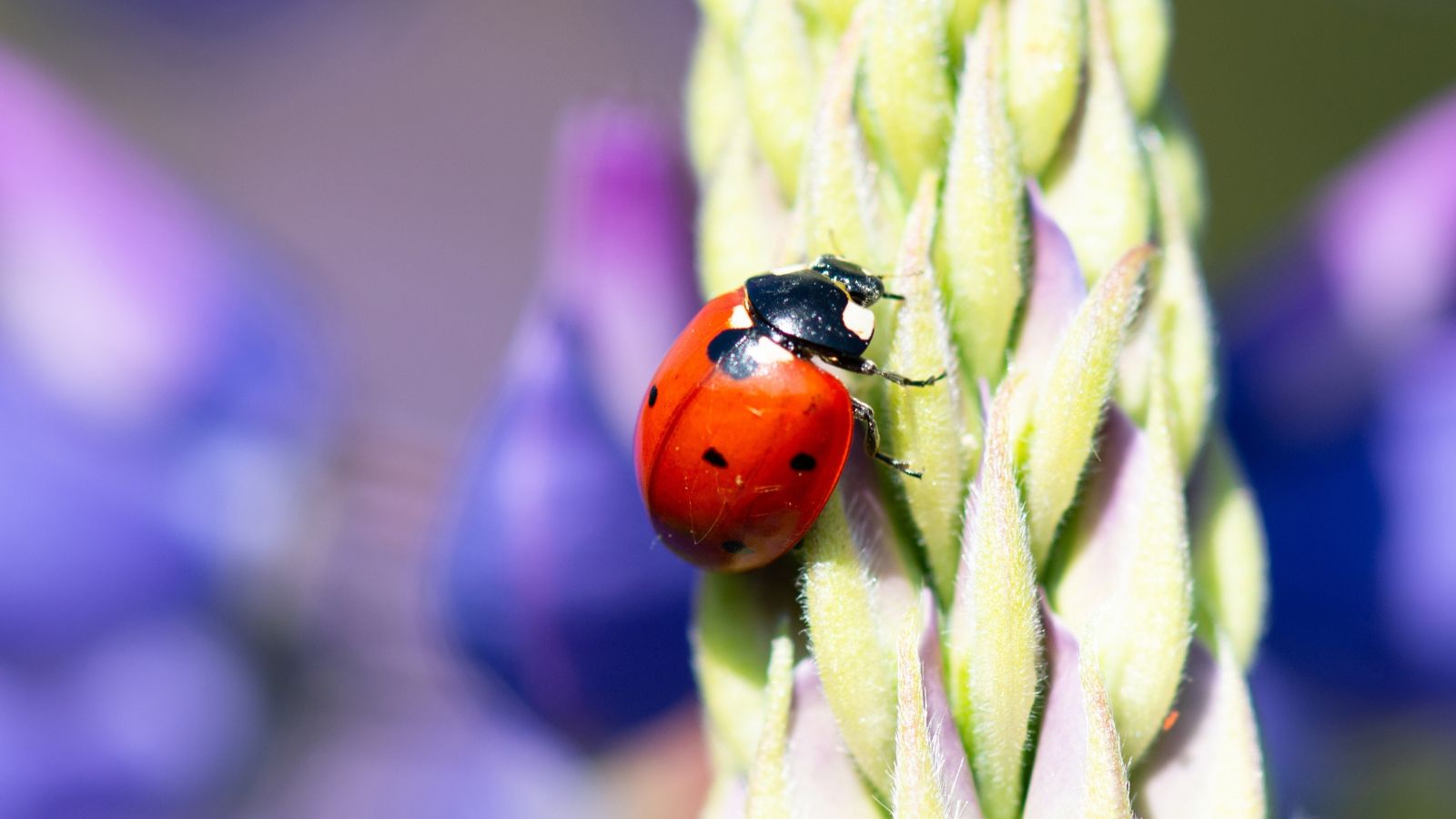 These spotty bugs look quite similar but have different impacts.
These spotty bugs look quite similar but have different impacts. Ladybugs are good garden bugs that favor bad aphids and other soft-bodied insects. They help control populations and keep the sap-sucking pests in check. Mites, mealybugs, thrips, whiteflies, and leafhoppers are also in their diet. As adults, and especially in the larval stage, they’re voracious feeders.
Pollen and nectar-rich blooms are a way to draw ladybugs. Flat-topped and umbel flowers like yarrow, milkweed, alyssum, calendula, fennel, and dill are good food sources. The presence of aphids, too, will keep them visiting.
Bean and Squash Beetles
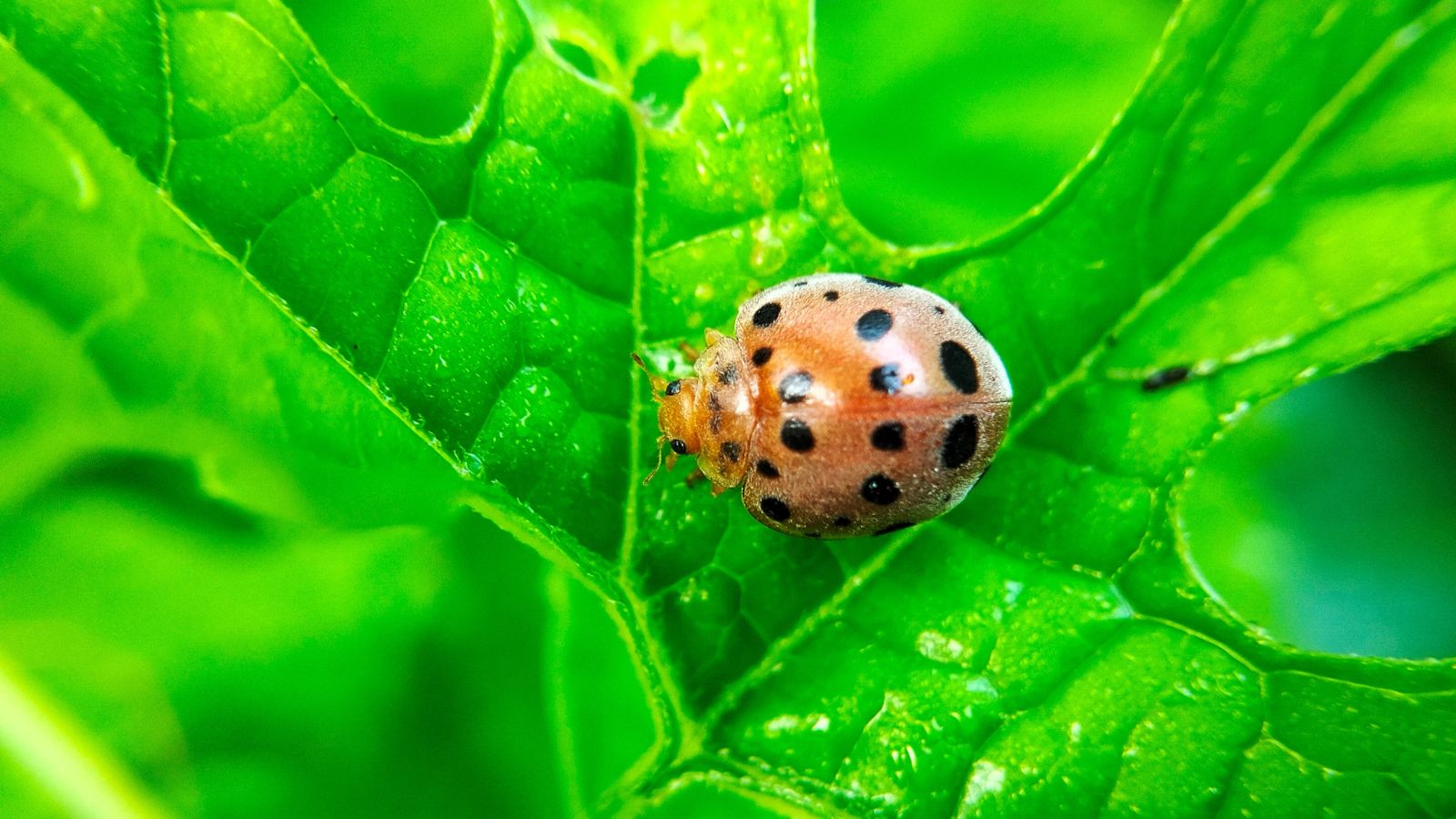 Bean and squash beetles leave holes in foliage,
Bean and squash beetles leave holes in foliage, While different species, these two spotted beetles look and act the same. They have a yellow-orange shell and head and more black spots than ladybugs (about 16). Larvae are fuzzy, spiny, and bright yellow. The yellow-orange eggs in clusters resemble ladybug eggs.
Bean and squash beetles feed on the tissues of their preferred hosts, skeletonizing leaves and reducing crop yields. You’ll notice chew damage on the leaf surface between the veins. They chew first in a semicircle to carve out their feeding area.
Treatment
 Pick bugs as soon as you see them.
Pick bugs as soon as you see them. Handpick the beetles, larvae (spiny yellow worms), and eggs (orange clusters on the underside of leaves) off the foliage. Toss them in a bucket or cup of soapy water to dispose of these bad garden bugs. For larger infestations, neem oil is a treatment option.
Prevention
 Remove garden debris in fall.
Remove garden debris in fall. Clear all debris at season’s end to limit the adults’ overwintering. Floating row covers for seedlings prevent early damage by blocking egg-laying and the feeding of hatching larvae. Remove the covers during flowering for pollination.
Interplant with companions like aromatic herbs to repel the pests with their essential oils. Rosemary, mint, and marigolds may help.
Assassin Bugs vs. Squash Bugs
There are hundreds of assassin bug species. Look for a slim body in black, red, or orange with long, spidery legs. A prominent proboscis or curved beak is a key identifier.
Nymphs are the size of ants or tiny spiders and may have the same red-orange coloration. Eggs are cylindrical, tube-like structures in clusters on the surface or underneath leaves.
Assassin Bugs
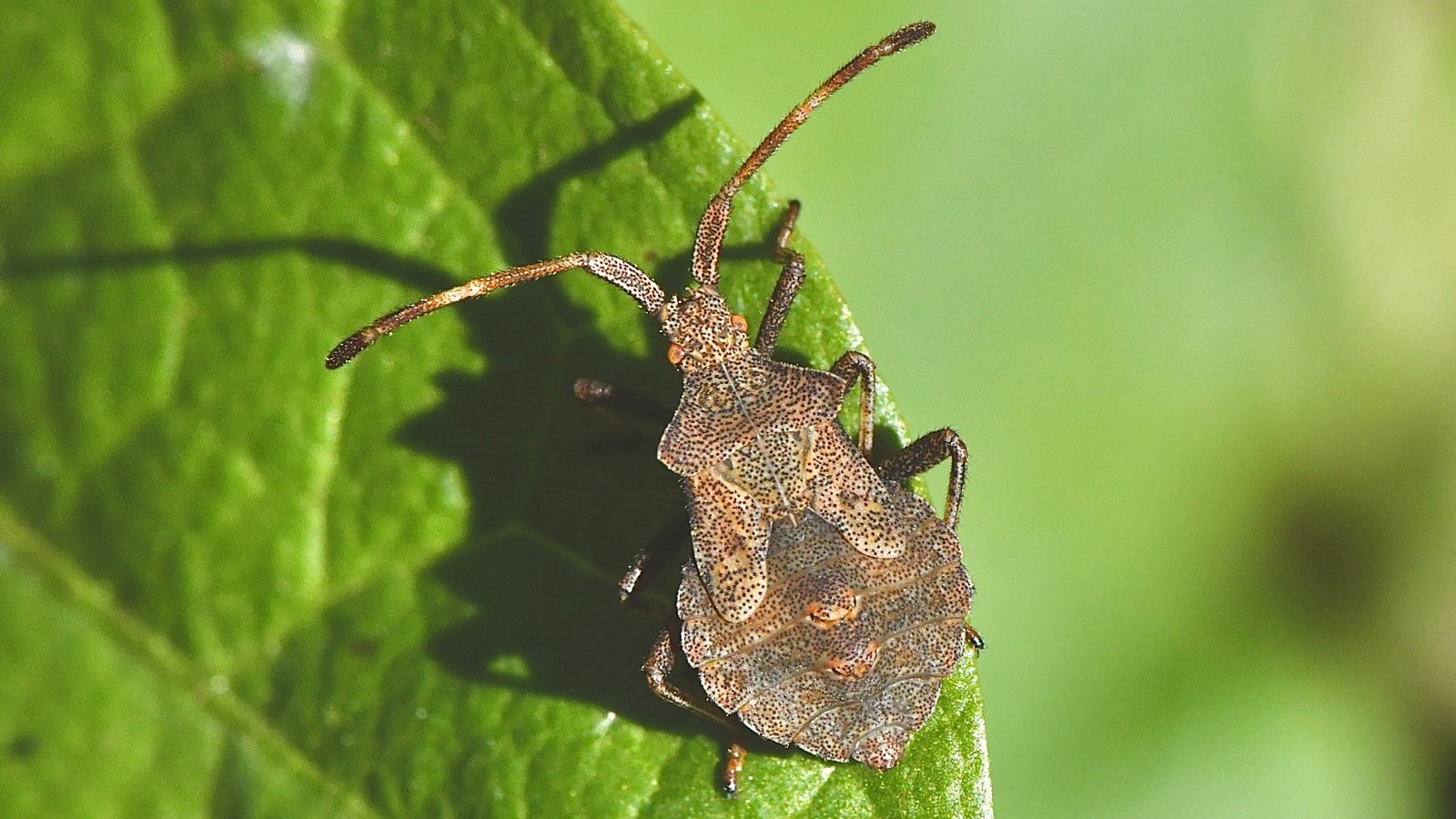 One feeds on harmful insects, the other on your plants.
One feeds on harmful insects, the other on your plants. Assassin bugs prey on common garden insects like cabbage worms, beetles, and aphids. It stalks and kills the other bad bugs, piercing them and ingesting them with a digestive poison to feed.
As with ladybugs, nectar-rich blooms are going to attract the assassins. Flowering herbs and native perennials are prime candidates to draw the beneficials for natural pest management.
Offer year-round habitat for assassin bugs (as well as other insects, including pollinators) by letting fall leaves remain in place. Leaving the leaves creates shelter for overwintering insects. They reemerge the following spring to continue the population.
Squash Bugs
 These bugs are common in vegetable gardens.
These bugs are common in vegetable gardens. Squash bugs are sap-sucking insects that deplete leaves of water and nutrients. The foliage becomes speckled and eventually wilts, turns brown, and drops. Squash bugs (Anasa tristis) are common pests among cucurbits and other crops.
The large, gray-brown insects have flat-winged, shielded backs. Small, spidery nymphs are pale green with black legs and mature to a darker gray. The adults overwinter in sheltered spaces under logs, rocks, and debris to begin mating and laying eggs at the time host seedlings emerge. Clusters of eggs in yellow-brown appear on leaf surfaces and undersides.
Treatment
 Horticultural oil is an effective control measure.
Horticultural oil is an effective control measure. Horticultural soaps, oils, and spinosad sprays may eradicate early numbers of the nymphs. The adults are tough to control as they travel, so catching them in the young phase offers the best success.
To protect beneficial insects, try removing eggs and nymphs by hand first. Squish the eggs or tear off the leaf portion that contains them.
Elusive adults and nymphs take cover under mulch and in hiding places at the soil level. Place a board, shingle, or piece of cardboard near the stem to offer them cover. Lift it in the morning to expose and destroy the congregating squash bugs. To reduce protective cover, remove mulch from the area if the numbers are high.
Prevention
 Choose resistant varieties to protect your harvests.
Choose resistant varieties to protect your harvests. If these bad garden bugs are a problem in your area, try planting seedlings early in the season to establish before the insects become most active (usually in June) or late for areas with long growing seasons. Grow resistant varieties, particularly Cucurbita moschata winter squashes, which have thick stems that deter egg-laying.
Practice good sanitation, removing debris after the final harvest to reduce overwintering habitat for adults. Use temporary row covers to shield the cucurbits until flowering.
Ground Beetle vs. Other Beetles
The long, dark, shiny, and elusive ground beetle spends most of its life rooting around mulch and leaf litter searching for prey. Mostly nocturnal, the black beetles are unsung heroes of the well-balanced garden system.
Ground Beetles
 Some beetles are beneficial, feeding on common garden pests.
Some beetles are beneficial, feeding on common garden pests. Ground beetles feed on caterpillars, weevils, slugs, ants, aphids, maggots, and other pests that pupate in the soil. They also feast on other beetles like Japanese and cucumber beetles that pupate in the mulch, leaf litter, and soil at the base of plants.
Mulch your crops and ornamentals to provide habitat for these good garden bugs to control bad ones. Logs, twigs, leaf litter, and rocks left in place provide additional hiding and foraging sites. Create undisturbed areas and avoid tilling to promote ground beetle populations.
Japanese Beetle
 These bugs reproduce incredibly quickly.
These bugs reproduce incredibly quickly. Japanese beetles feed on leaves and cause them to turn yellow and drop. Their voracious appetites can also skeletonize the leaf completely.
Beetle populations increase in numbers for several weeks in the summer, depending on their local activity. Roses and fruit trees are Japanese beetle favorites, but they enjoy a range of ornamental and edible crops.
Cucumber Beetle
 There are several species of this harmful beetle.
There are several species of this harmful beetle.Cucumber beetles are capable of severe damage to cucurbits, especially to young plants. The adult beetles feed on leaves, blossoms, and fruits, while the larvae feed on roots and stems. Their quick feeding damages and kills the specimen in severe infestations. The beetles are also vectors for cucumber mosaic virus and bacterial wilt, which kill infected crops.
There are three main species of cucumber beetles: the banded (Diabrotica balteata), the striped (Acalymma vittatum), and the spotted (Diabrotica undecimpunctata howardi). Each is yellow to yellowish green with distinct markings. The larvae are white to yellow-white and may be below the soil level or boring into stems.
Beetle damage can appear on all parts of the plant, including the fruits themselves. Signs of these bad garden bugs include irregular, jagged holes in leaves from their chewing.
Treatment
 Use control sprays as a last resort only to protect pollinators.
Use control sprays as a last resort only to protect pollinators.To control Japanese and cucumber beetles, handpick small populations or gently shake the branches. Drop them into a bucket of soapy water for disposal.
Treat the surrounding soil with two applications of beneficial nematodes, which target the grubs as food. Space the applications two weeks apart in the warm season.
Floating row covers can help while plants are young, as they block the pests from feeding on tender growth. Remove the covers as the seedlings mature and begin flowering for pollination and fruit set.
Pyrethrin sprays, spinosad, and neem oil also help treat the beetles. They’re most effective with regular treatments for transplants and seedlings during beetle activity, though they impact other insects as well, including pollinators and beneficial predators.
Prevention
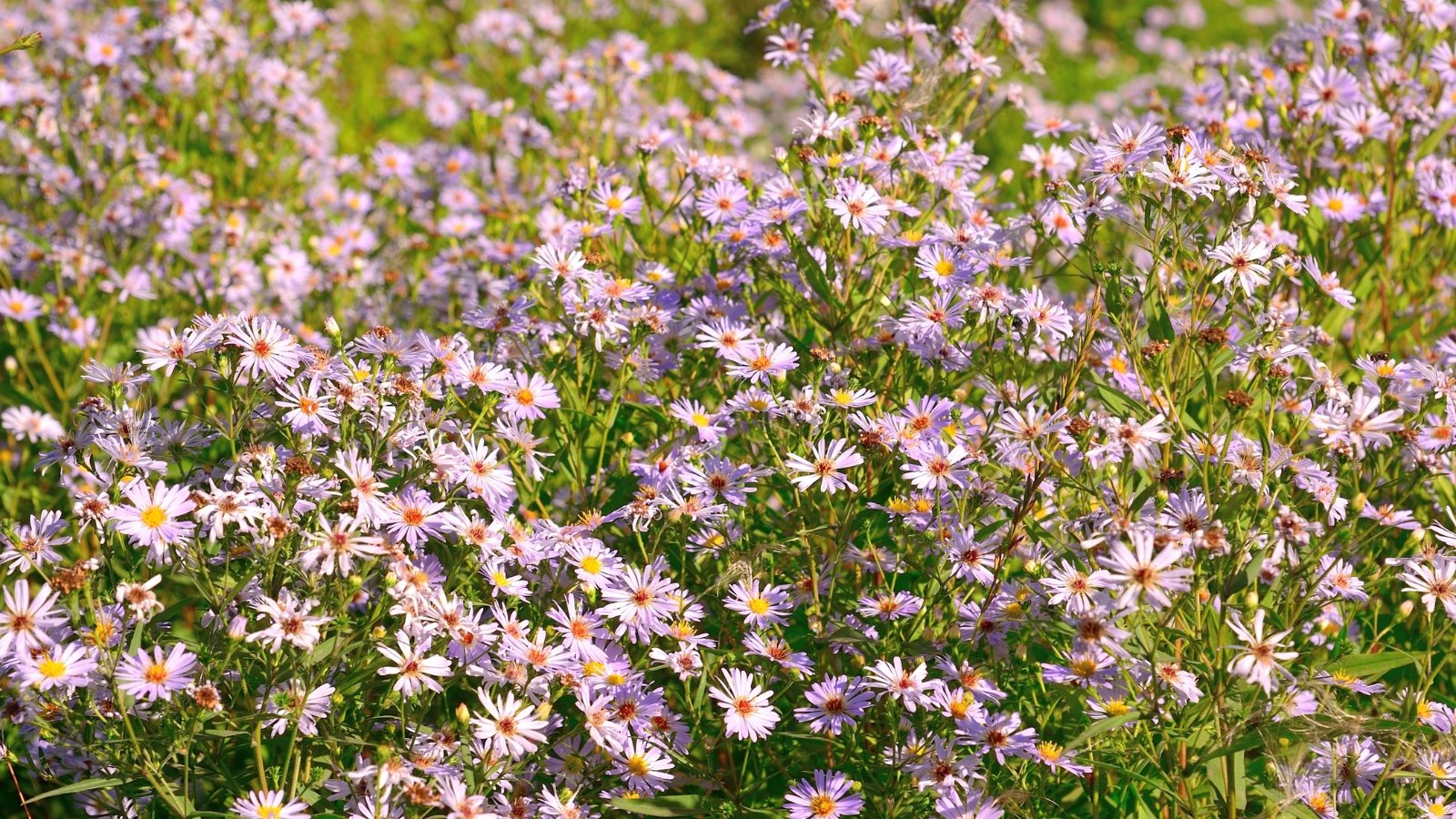 Growing more flowers attracts the right beneficial insects.
Growing more flowers attracts the right beneficial insects. Keep the surrounding areas weed-free to reduce the spread of beetles. Grow flowering perennials like asters, yarrow, and coreopsis, and herbs like dill, parsley, and chamomile that attract tachinid flies, soldier bugs, lacewings, and ladybugs. The natural predators feed on the eggs, larvae, and adult beetles.
Try planting after the active emergence of the beetles. By mid-June, they’ll emerge and move on to search for hosts. Planting late can help seedlings skip the larval stage.
Leopard Slug vs. Common Slug
Leopard slugs have leopard-like patterning on their long bodies (they reach up to six inches long). The spots set them apart from other common slugs and snails.
Leopard Slugs
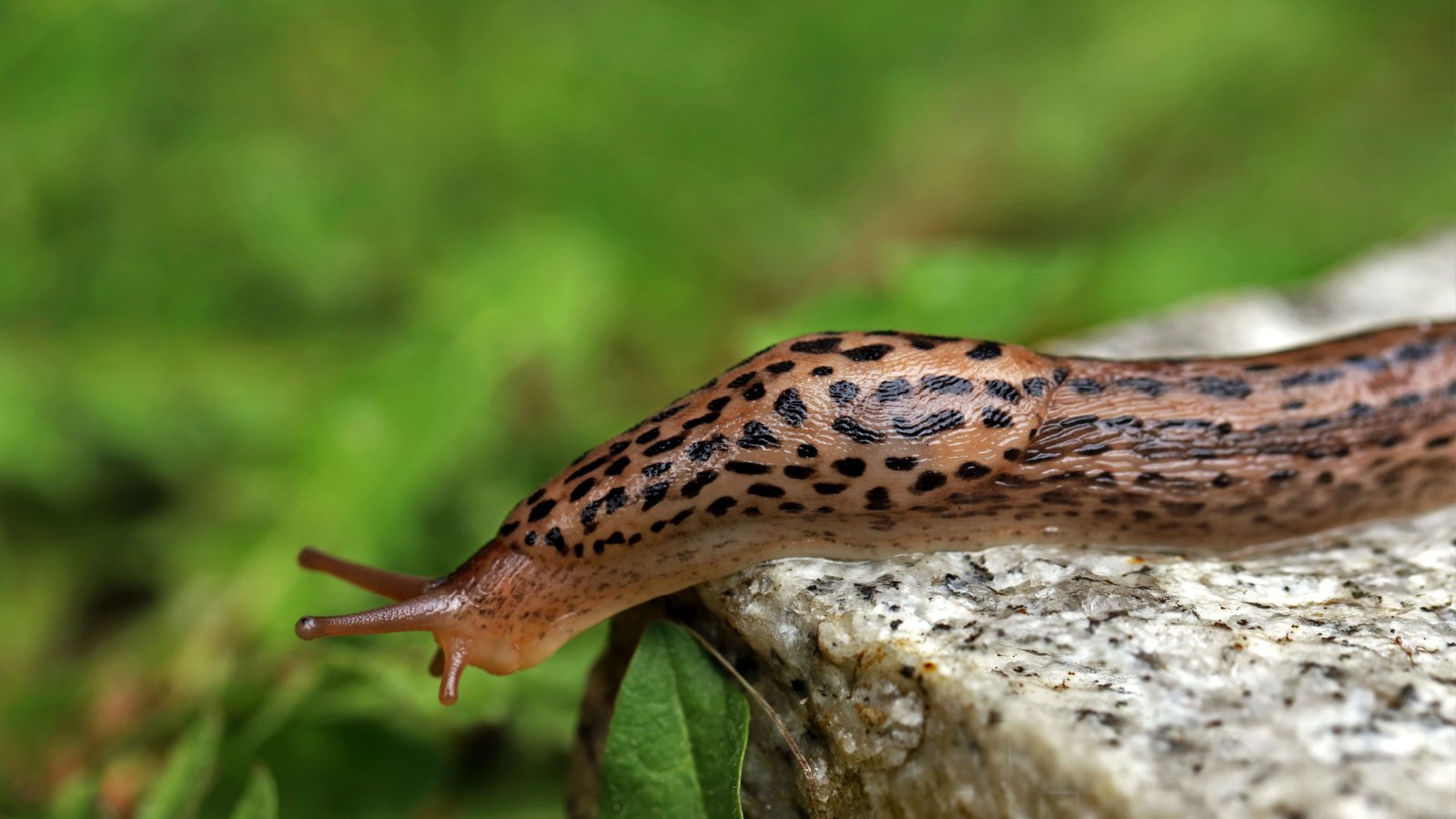 These slugs help break down organic matter.
These slugs help break down organic matter. Leopard slugs feed on decaying organic matter, enriching soils with nutrients as they go. These good garden bugs are also predators of bad slugs. With enough organics present, they won’t damage garden plants.
Provide compost piles as food and shelter for leopard slugs. They work to break down the material and are an asset in the pile. Logs, rocks, and leaf litter also benefit the slugs as protective cover and forage sites. If you can tolerate it, leave a few common slugs in place as food for the predators.
Common Slug
 Snails and slugs often feed on leafy garden plants.
Snails and slugs often feed on leafy garden plants. Common slugs and snails often graze on tender leaves, especially fresh shoots, fruits, and buds. You’ll notice their slimy trail, nibble damage, and even the pests themselves, especially at dusk and dawn when they’re most active.
Treatment
 Make your own traps to catch harmful slugs.
Make your own traps to catch harmful slugs.Scout during their most active times to hand-pick slugs and snails from plant surfaces. In the middle of the day, they’ll tuck in under leaves or on the mulch and soil around the crowns. Lure them with lettuce leaves or citrus rinds and collect them in the morning.
If numbers increase, bait them with beer or soda traps by filling a shallow dish and placing it at soil level. Diatomaceous earth scattered around the base of plants prevents them from reaching the stems to climb.
The sharp texture of the powder harms soft-bodied, crawling organisms. Organic slug baits are effective, too, though each of these methods can also kill leopard slugs, so take care when choosing a method.
Prevention
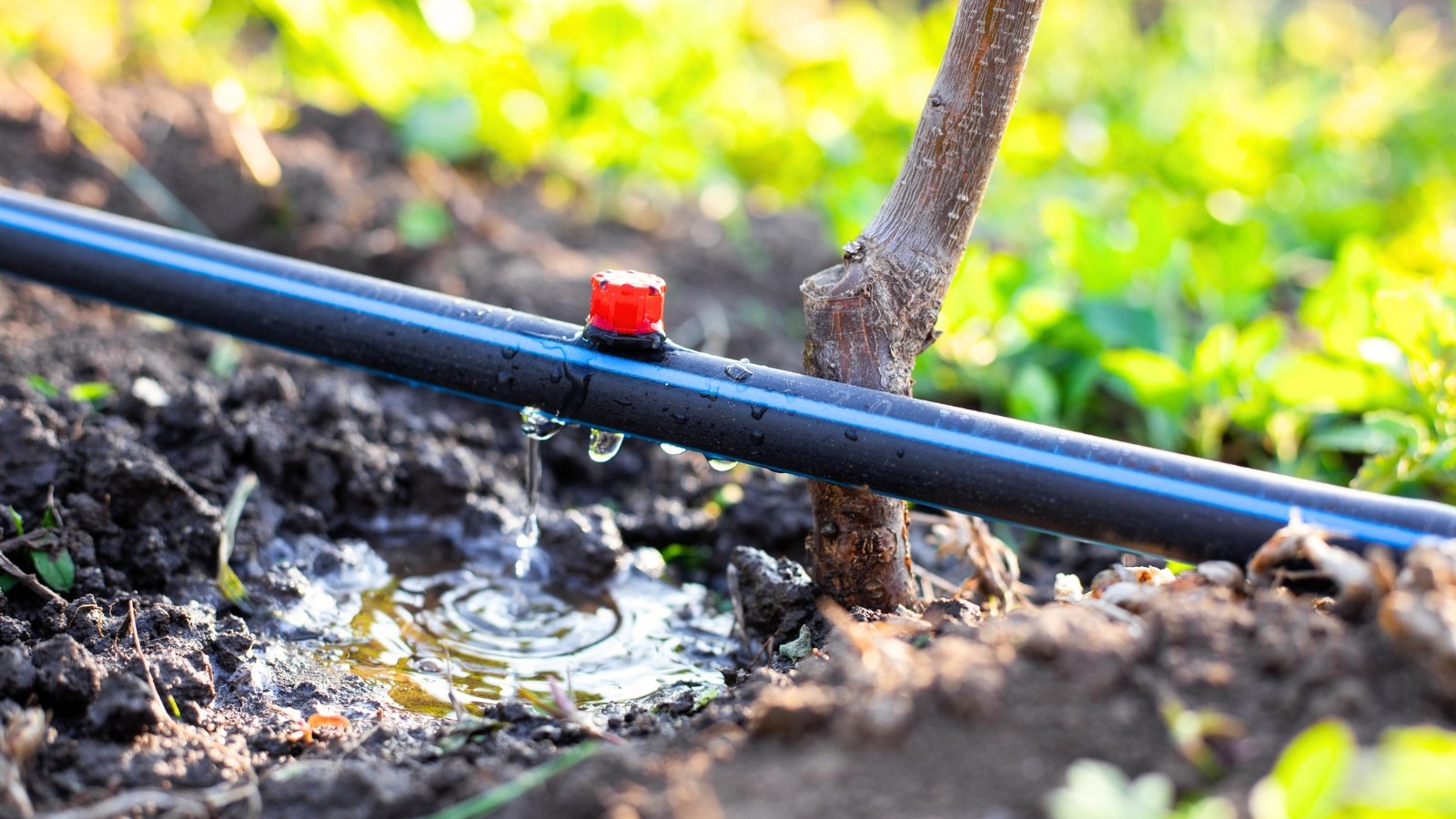 Drip irrigation keeps plants watered without creating overly moist conditions.
Drip irrigation keeps plants watered without creating overly moist conditions. Target irrigation to reduce moist conditions, which are an inviting habitat for the creatures. Drip irrigation at the base delivers water directly to the roots without wetting the overall surface area. Remove mulch from around the base to reduce slug hiding spots.


 23 hours ago
12
23 hours ago
12
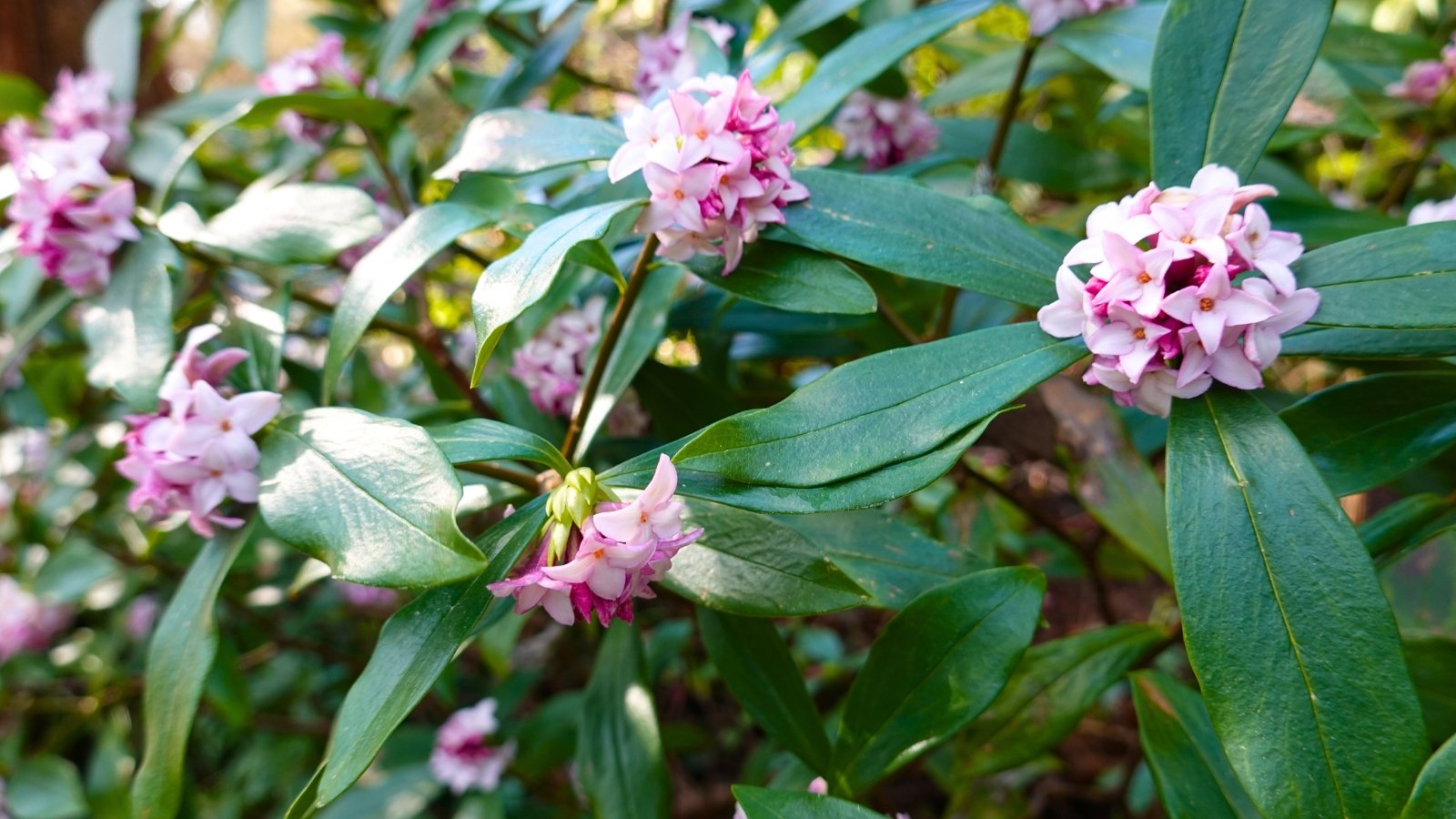

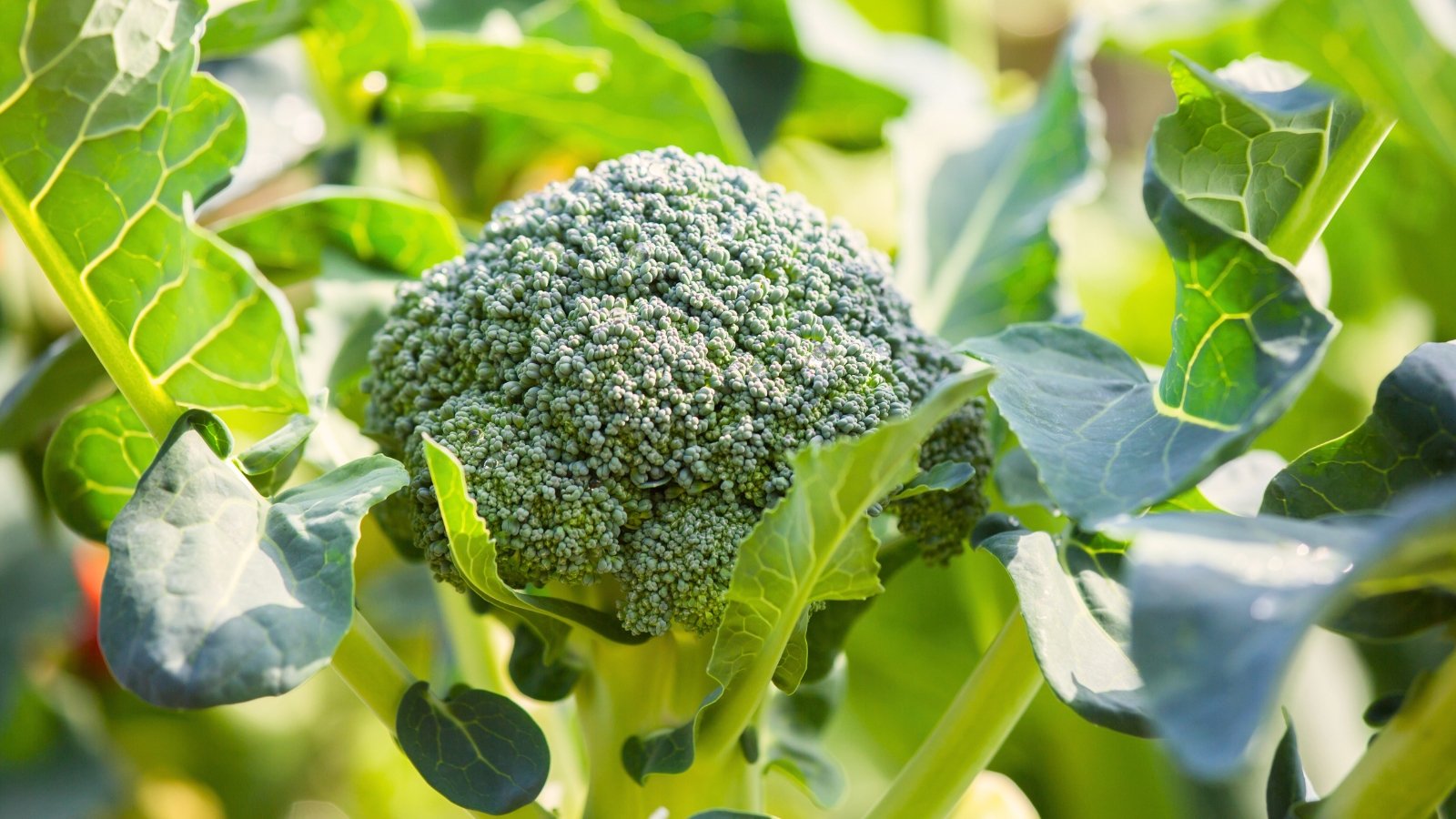



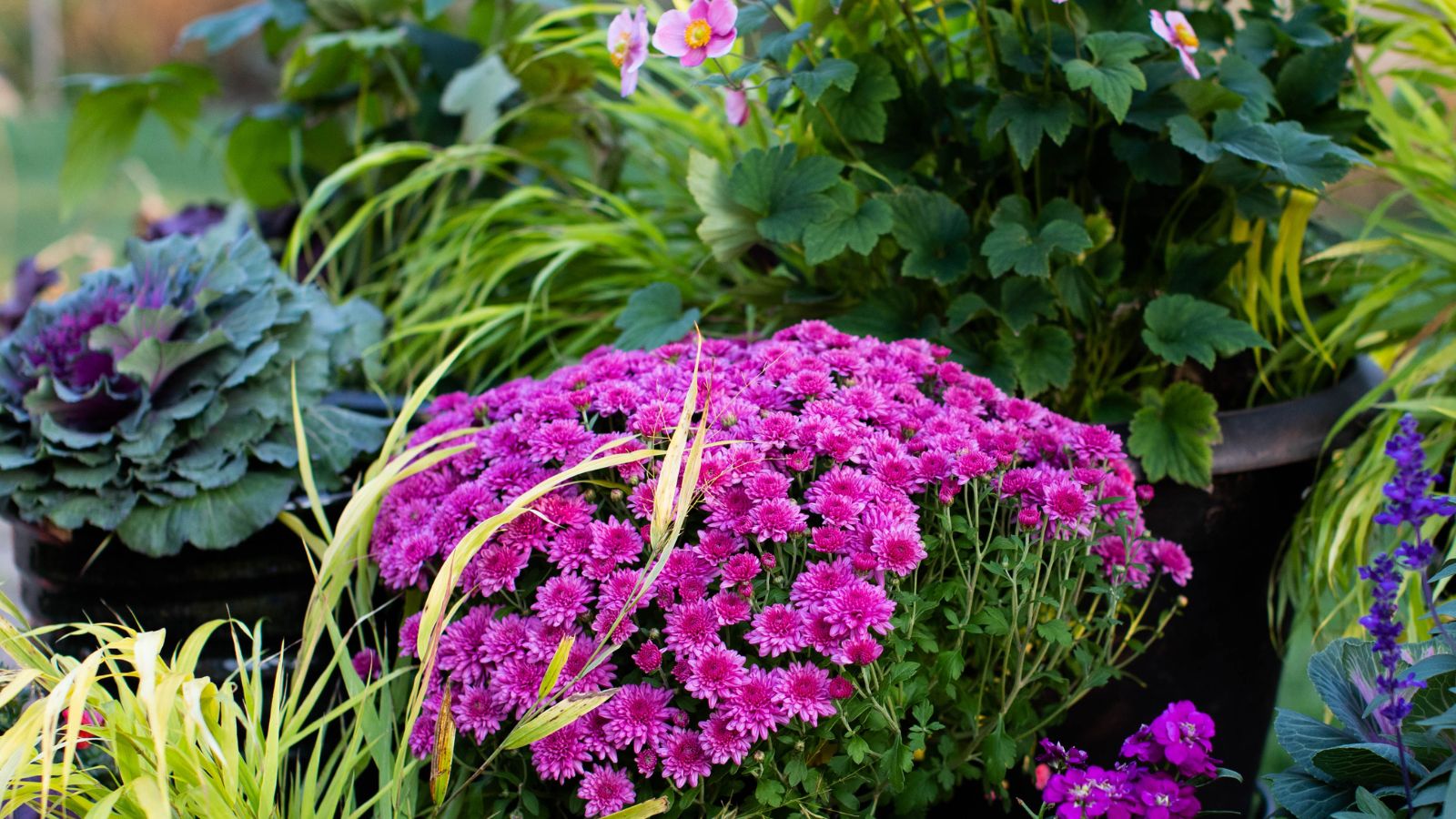














 English (US) ·
English (US) ·  French (CA) ·
French (CA) ·